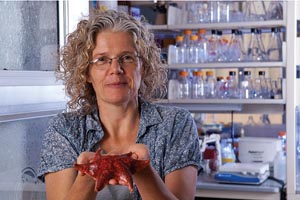Press Release: Carnegie Mellon Biologists Find Regulatory Networks Responsible for Neuron Development in Starfish
Contact: Jocelyn Duffy / 412-268-9982 / jhduffy@andrew.cmu.edu
 PITTSBURGH-Developmental biologists at Carnegie Mellon University have identified the gene regulatory networks (GRNs) responsible for the creation and organization of neurons in starfish. The findings, published in the May 21 issue of the Proceedings of the National Academy of Sciences, provide a better understanding of how genes are regulated in order to form complex patterns of neurons.
PITTSBURGH-Developmental biologists at Carnegie Mellon University have identified the gene regulatory networks (GRNs) responsible for the creation and organization of neurons in starfish. The findings, published in the May 21 issue of the Proceedings of the National Academy of Sciences, provide a better understanding of how genes are regulated in order to form complex patterns of neurons.
All animals start out pretty much the same, as a fertilized egg that quickly divides into many different cells. In fact, most organisms - from the simple fruit fly or starfish to the complex human - contain the exact same set of developmental genes called the developmental gene toolkit. The genes are regulated by complex signaling pathways called GRNs that tell nascent cells what type of cell they should become.
"During development, your genes need to be turned on and off at precisely the right time. If just one turns off too early, the entire developmental process could be affected," said Veronica Hinman, associate professor of biological sciences at Carnegie Mellon. "It's important that we study how these genes are regulated in order to determine how cells become so robustly specified."
In the current study, Hinman and colleagues identified two GRNs responsible for neuronal cell differentiation in the larvae of starfish. Ancestors of starfish formed neurons that existed throughout the organism's body without any pattern in a structure called a nerve net. The nervous system of starfish larvae evolved to the next step in complexity, organizing in a distinctive pattern.
"Starfish are a relatively simple system to understand. They have only around 100 neurons, where a human has billions," Hinman said. "But those 100 or so neurons are very interesting because they form very intricate patterns along two loops from the front to the back, and top to bottom, called ciliary bands."
The researchers found that there are two GRNs that control neuron development in starfish larvae. First, a specification GRN that involves the cWnt-signaling pathway causes the larvae to form neural cells. A second, patterning GRN, which involves the foxg gene and Bmp2/4 and Six3 signaling pathways, sculpts out the two ciliary bands. Newly formed neural cells then form along these bands. By using two GRNs, starfish larvae can make neurons using the specification network and then figure out the best way to position the neurons by evolving the patterning network.
Hinman plans to continue this research to better understand the pluripotent capabilities of cells in starfish larvae. Her research group will further investigate the evolution of the patterning mechanism. "If we know what signals cause cells to become certain things, we could potentially change the signals and change what the cell becomes," Hinman said.
Co-authors of the study include Kristen A. Yankura, a former graduate student who is now a postdoctoral researcher at the University of California, Los Angeles; Clare S. Koechlein, a former undergraduate student who is now a doctoral student at University of California, San Diego; and Carnegie Mellon undergraduate student Abigail F. Cryan and graduate student Alys Cheatle.
The study was funded by a National Science Foundation grant (0844948) and a Howard Hughes Medical Institute Undergraduate Education Grant (52006917).
###
Veronica Hinman, associate professor of biological sciences at Carnegie Mellon, and colleagues have been studying gene regulatory networks in starfish.